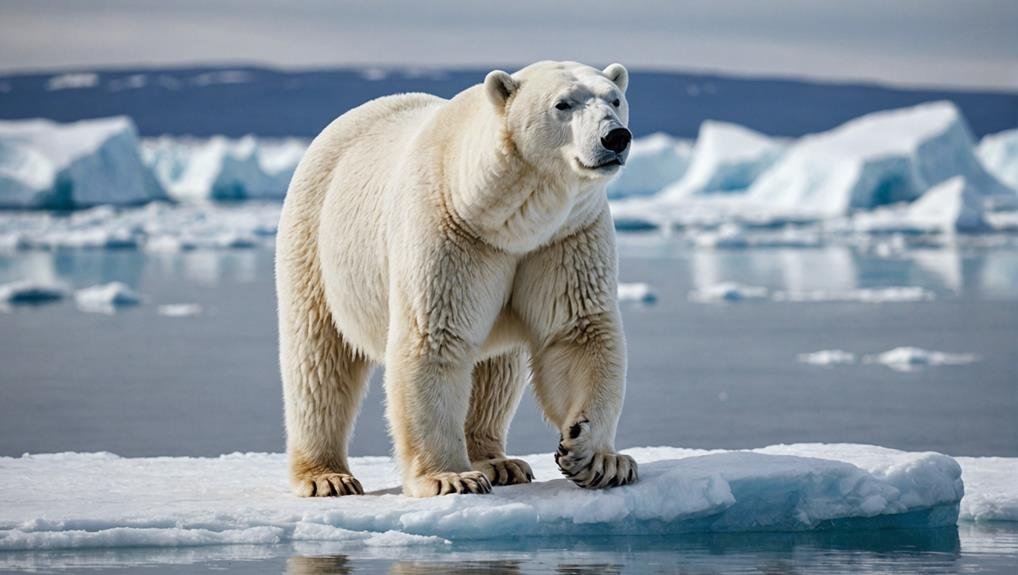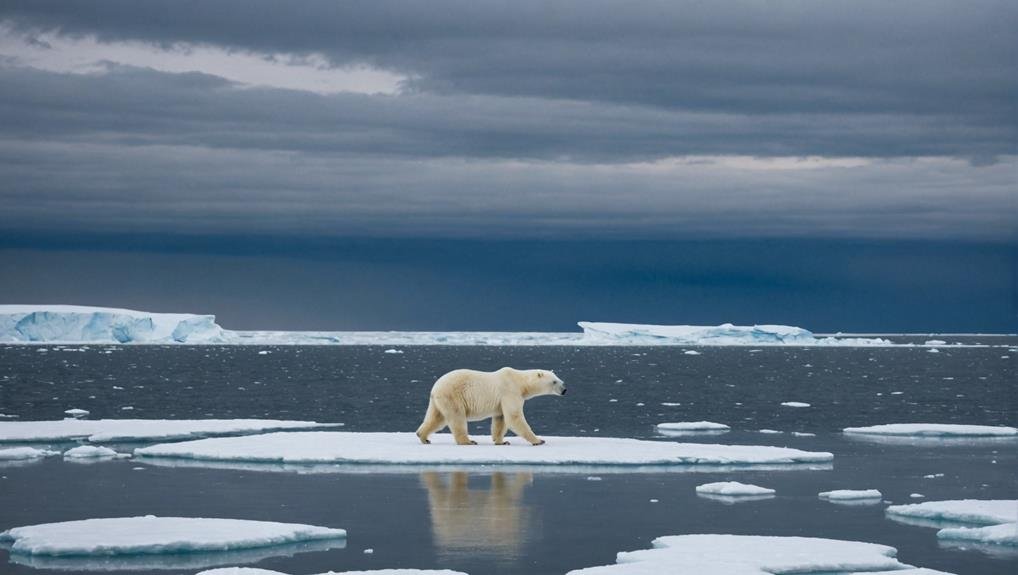Polar bears remain on the endangered list primarily due to climate change and industrial threats. The warming Arctic results in the melting of sea ice, critical for their hunting and breeding. Each decade, summer sea ice shrinks by about 13%, compelling polar bears to adapt to less ice and altered habitats. Additionally, industrial activities like oil drilling and increased shipping pose significant risks, disrupting their environment and increasing the likelihood of oil spills. Despite ongoing conservation efforts, these challenges persist, leading to a decline in polar bear populations. Understanding more about these impacts could reveal further subtleties in their struggle for survival.
Main Points
- Climate change is rapidly melting the sea ice essential for polar bears' survival.
- Reduced sea ice limits access to main food sources, impacting their health and reproduction.
- Habitat destruction from industrial activities like oil drilling further threatens their environment.
- Polar bear populations are declining in key areas like the Southern Beaufort Sea and Western Hudson Bay.
- Conservation efforts are ongoing, but current challenges outpace the rate of successful intervention.
Threats From Climate Change
As climate change continues to melt their sea ice habitat, polar bears face increasing threats to their survival. The relentless rise in global temperatures is rapidly transforming the Arctic ecosystem, where these iconic creatures have thrived for millennia. Every decade, a staggering 13% loss of summer sea ice is recorded, critically undermining the polar bears' ability to hunt seals, their primary food source. This shrinking ice landscape not only threatens their feeding patterns but also their breeding and denning practices.
You mightn't realize it, but the loss of sea ice habitat leads directly to food deprivation. Polar bears rely on thick sea ice to reach their prey, and without it, they must travel greater distances, expending more energy with less success in catching food. This severe scarcity of food negatively impacts their health, leading to a decline in their physical condition and reduced fat reserves necessary for reproduction and nursing of cubs.
Moreover, the health decline dovetails with decreased reproduction rates among polar bears. Weaker, undernourished females are less likely to conceive, and those that do often can't support their cubs to maturity, further endangering the future of polar bear populations.
Acknowledging these dire circumstances, conservation efforts have ramped up, aiming to mitigate the impact of climate change on these majestic animals. Protecting the Arctic's integrity isn't just about saving polar bears but preserving a complex ecosystem that supports a diverse range of life. Your awareness and support for ongoing conservation initiatives are pivotal in turning the tide for polar bears as they navigate the challenges posed by our changing climate.
Habitat Destruction Impact
Polar bears' survival is increasingly jeopardized by the loss of over 1 million square kilometers of summer sea ice in just 15 years, severely impacting their critical habitats. This loss, driven by climate change, has led to significant habitat destruction, leaving polar bears struggling to find stable ground for hunting and breeding.
As you're aware, the Arctic's sea ice is essential for polar bears; it's where they hunt seals, their primary food source. With the shrinking ice, bears are facing food deprivation, which in turn affects their health and reproductive capabilities. The regions of the Southern Beaufort Sea and Western Hudson Bay exemplify this crisis, showing marked declines in polar bear populations. These areas, once teeming with life, now serve as stark examples of how rapid environmental changes can decimate critical wildlife populations.
Moreover, shifts in denning areas are symptomatic of the broader issue of habitat destruction. Denning sites, essential for the birth and early survival of cubs, are being altered or lost, complicating maternal efforts to nurture new generations. As these traditional denning areas become less accessible, the energy and risks involved in finding new sites can further stress the endangered species.
The situation in the Arctic is a clear indication of the broader implications of habitat destruction. As sea ice continues to recede, the very existence of polar bears hangs in the balance. Understanding and addressing the impacts of this habitat loss are essential for the conservation of polar bears, which remain a symbol of the Arctic's wild majesty yet are a poignant reminder of its fragility.
Conservation Efforts Overview

Recognizing the dire situation, numerous conservation efforts are underway to protect polar bears and their diminishing habitat. Organizations like the World Wildlife Fund (WWF) are at the forefront, deploying global teams focused on climate and energy issues essential for the survival of these endangered species. Their initiatives not only concentrate on the immediate threats but also fund essential research into the impacts of climate change and the development of alternative energy solutions.
These conservation strategies are multifaceted. Advocacy has successfully led to the establishment of a circumpolar management plan, designed to coordinate efforts across the Arctic to safeguard these majestic creatures. This plan is critical, as it provides a structured approach to addressing the various threats polar bears face across different regions.
On a local level, innovative projects are being implemented to mitigate human-wildlife conflicts, which are increasingly prevalent as polar bears come into closer contact with human settlements. For example, communities are adopting steel food storage containers to prevent bears from scavenging, thereby promoting safer coexistence.
Habitat protection remains a cornerstone of conservation efforts. Researchers are tirelessly working to pinpoint critical areas that require protection, ensuring that these habitats are preserved. Collaboration with partners is key to implementing sustainable practices that will help maintain the Arctic environment.
All these efforts are interconnected, forming a robust network aimed at combating the myriad challenges polar bears face. Through continued research, advocacy, and local engagement, there's hope for stabilizing and eventually increasing polar bear populations, ensuring they remain a part of our world's natural heritage.
Role of Industrial Activities
Industrial activities, especially in oil and gas sectors, dramatically heighten the threats to polar bears in their Arctic habitats. As you explore the Arctic's vast, icy expanse, it's essential to understand the impact of these activities on one of its most iconic inhabitants. Oil and gas development not only disrupts the fragile ecosystem but directly threatens the survival of these majestic creatures.
The expansion of offshore petroleum operations is particularly alarming. With the Arctic ice melting, new areas become accessible for oil exploration, increasing the likelihood of oil spills. Such spills are disastrous for polar bears as the oil can cling to their fur, reducing its insulating effectiveness and increasing the risk of hypothermia. Additionally, the presence of oil in their environment can lead to ingestion of toxic substances, which compromises their health.
Beyond the spills, the noise and disruption from seismic blasting and construction associated with extracting resources can disturb the polar bears' natural behaviors. These disturbances can lead to a lack of food, as polar bears rely heavily on a stable environment to hunt seals, their primary food source. The noise can scare off their prey and force bears to expend more energy searching for food, further stressing their already vulnerable population.
Increased shipping traffic compounds these issues, introducing more noise and potential for oil spills, while also posing a physical threat to the bears themselves. Every ship that passes through the Arctic waters can disrupt the sea ice, crucial for the polar bears' hunting activities.
Understanding these impacts is essential for their conservation. Protecting polar bears involves not just regulating these industrial activities but also ensuring they don't irreversibly harm the species' chances of survival in their native habitat.
How to Support Polar Bears

While understanding the severe impacts of industrial activities, you can also play a direct role in supporting polar bear conservation. By donating to organizations like WWF and Polar Bears International, you contribute directly to efforts that protect these endangered species and their diminishing habitat. Polar bears rely on sea ice for hunting and breeding, and with global warming accelerating the loss of this essential habitat, every contribution towards conservation helps.
Additionally, you can take personal steps to reduce carbon emissions. Opting for renewable energy sources, minimizing vehicle use, and improving energy efficiency in your home are actionable ways to lessen your carbon footprint. These efforts help slow down the melting of sea ice, thereby providing polar bears with a better chance of survival.
Supporting initiatives aimed at reducing human-wildlife conflicts is also crucial. As polar bears face habitat loss, they increasingly come into contact with human settlements, leading to dangerous encounters. By advocating for and supporting strategies that mitigate these conflicts, you help safeguard the safety of both polar bears and local communities.
Moreover, pushing for stricter regulations on industrial activities in the Arctic can limit further damage to polar bear habitats. Engaging with policymakers and participating in public forums to voice your support for such regulations are effective ways to influence change.
Frequently Asked Questions
Why Are Polar Bears Endangered in the World?
You're wondering why polar bears are endangered globally.
It's primarily due to climate change leading to Arctic warming and melting ice, which disrupts their habitat. This habitat loss affects their hunting grounds, leading to food scarcity.
Additionally, pollution impact, reduced genetic diversity, and human encroachment further threaten their survival.
Despite hunting regulations and conservation efforts, these challenges persist, making it tough for polar bear populations to recover effectively.
When Were Polar Bears Put on the Endangered List?
Polar bears were listed as a threatened species under the Endangered Species Act in 2008. This decision was based on extensive scientific research and habitat analysis showing their critical dependence on diminishing sea ice.
The listing spurred global awareness, drove international cooperation, and influenced conservation policies and regulatory changes, all aiming to mitigate climate debates' impacts.
Legal impacts and public engagement have also played vital roles in ongoing efforts to protect these majestic animals.
Can Polar Bears Still Be Saved?
Yes, polar bears can still be saved through concerted global efforts.
You'll need to support strong conservation strategies, enhance habitat restoration, and maintain genetic diversity.
International cooperation and increased climate action are essential.
Raising public awareness, securing research funding, and establishing wildlife corridors will also contribute substantially.
It's important to maintain ecological balance and understand predator-prey dynamics to guarantee the survival of polar bears in their rapidly changing environment.
Why Are Bears Endangered?
You might wonder why bears are endangered. Primarily, habitat loss due to climate change, specifically Arctic warming and ice melting, severely impacts them.
Also contributing are factors like illegal hunting, pollutant exposure, and food scarcity, which affect their health and reduce genetic diversity. More frequent human interaction exacerbates these issues.
Conservation efforts are crucial to mitigate these threats and guarantee the survival of bear populations struggling with these challenges.
Are Recent Conservation Efforts Helping Polar Bears Move Off the Endangered List?
Recent conservation efforts show promising signs for polar bear populations, with many initiatives focused on mitigating climate change and protecting their natural habitats. The latest polar bear conservation strategies aim to ensure these iconic animals have a future, though it’s still uncertain whether they can move off the endangered list anytime soon.
Conclusion
As you've learned, polar bears continue to confront climate calamities and habitat havoc, perilously pushed by persistent industrial pursuits. Conservation campaigns are essential, yet challenges remain monumental.
You can contribute to their conservation by supporting sustainable practices and advocating for policies prioritizing polar bear preservation. By understanding and addressing the intricate issues impacting these majestic mammals, your efforts can help make sure they don't just survive but thrive in their frigid homes.


